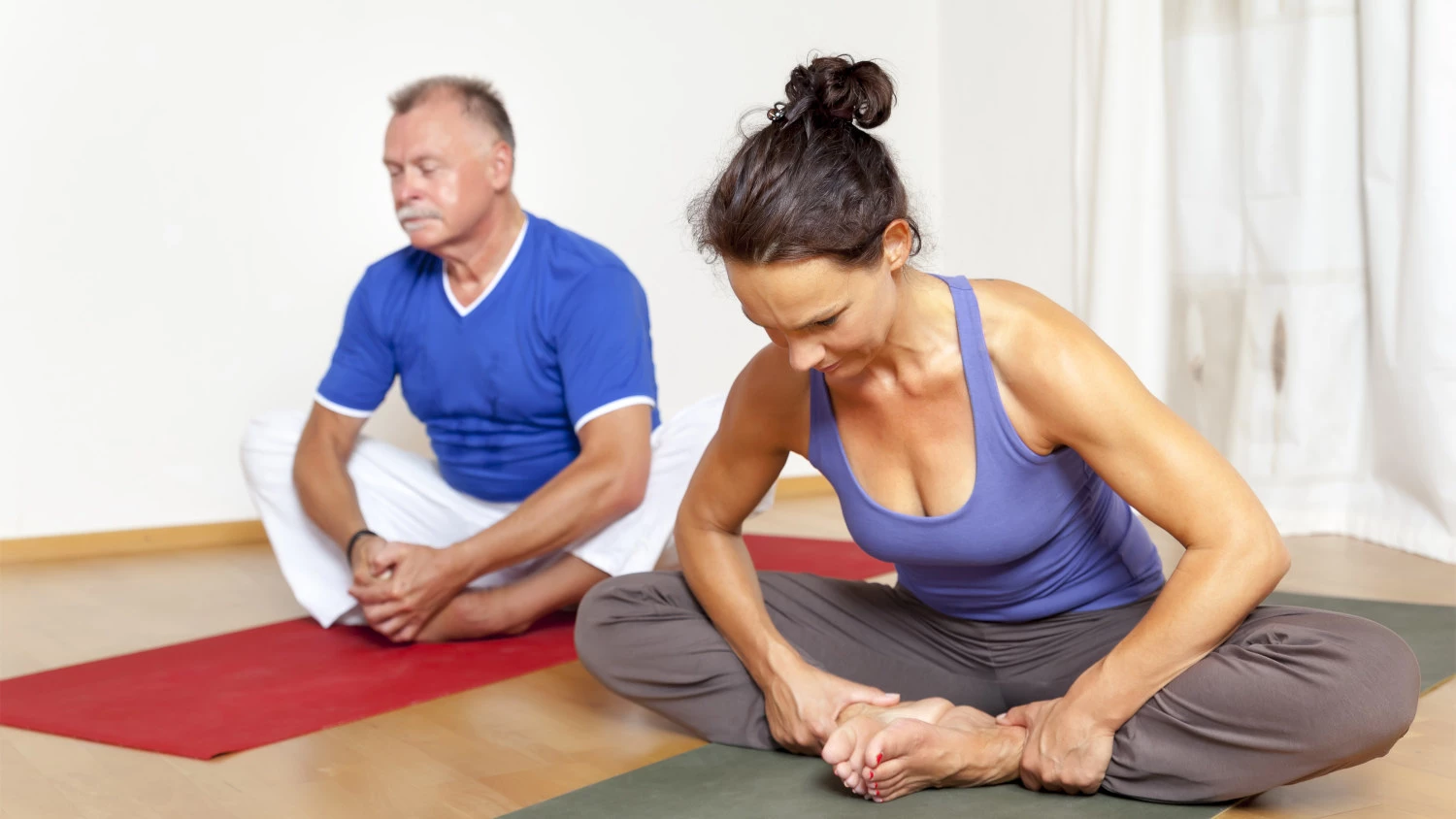Honoring Your Boundaries

I was 50 minutes into a 90-minute hot yoga class when I knew something was wrong. Actually I knew 15 minutes into class; I just chose to ignore it. At 50 minutes though, there was a real problem. As I moved through Down Dog my ears felt like they were going to explode and the room began to fade. I was about to pass out.
Quickly I dropped to Child’s Pose until the feeling passed. While the rest of the class spent the remaining time doing handstands and other fancy poses, I scooted myself to the corner and chose a more restorative inversion of Legs Up the Wall.
Did I wimp out of class that day? Not at all.
It was a much-needed reminder that all yogis, beginners and even we teachers, need to honor our boundaries every single time we step on the mat.
What does honoring your boundaries mean in yoga? It means being aware of the difference between what your mind wants and what your body needs.
The word yoga is derived from the Sanskrit word yuj and translated means to yoke or bind. It is most often interpreted as a union between the mind and the body.
Your mind is telling you everyone else in class is doing this fancy pose so you better do it too or everyone will know you don’t deserve to be in a Level 2 class. It’s self-imposed pressure and judgment making you feel like you have to compete. The big question to ask yourself is, “Is this my ego telling me to go for it (your mind), or is my body saying yes, that pose will feel good, helpful and healing?”
Learning to listen to your body is one of the most important benefits of yoga. Our bodies are designed to give us constant feedback for optimal health. We just have to learn to listen and trust what we are hearing.
Once you become more attuned to the cues your body gives you, you’ll find yourself self-correcting negative postural habits, making healthier food choices and even finding the ability to step away from toxic situations in your daily life off the mat.
Lisa Nassal is a yoga student of mine that is excellent about listening to her body and honoring her boundaries. I often see her in class resting in Child’s Pose or choosing an alternative pose from what the rest of the class is practicing. I asked Lisa what made her finally realize some poses just weren’t best for her.
“Unfortunately I had to hurt myself to realize I was forcing myself into positions rather than easing into them,” she said. “I don’t force myself to do anything anymore. Now yoga has taught me to be content with me, on and off the mat!”
In fact, Lisa is trying to encourage her children, who don’t yet practice yoga, to be content with themselves and honor their boundaries in their own life.
Beginning a yoga practice will give you a new awareness of your body, your mind and the needs of both. Like my student Lisa had to learn, it is best to ease into your yoga practice, and ease into each yoga pose, to best honor your boundaries.
-
Start where you are. If you are new to yoga or just getting into a fitness routine, a beginner’s class will be ideal for you. Beginner doesn’t mean “not as good.” It simply means you are beginning your practice. If you’ve been ill or dealing with a chronic health issue, consider a restorative yoga class where poses are supported with props and held for longer, more restful periods.
-
There is nothing magical about the floor! For some reason this is the hardest idea to teach my students. You are not a superstar yogi if your hands can lay flat on the floor in a forward fold. If you have tight hamstrings or a lower back issue, placing your hands on blocks in forward fold is safer for your body and allows you to fit your practice to your needs.
-
The use of props is essential to making your yoga practice fit your body. Blocks, bolsters, chairs and straps are nothing more than tools to help you meet yourself exactly where you are for that day. The right prop can help teach a skill necessary to balance your body, even preparing it for the more advanced poses.
-
No pain no gain is not a yoga mantra! Although some yoga classes are more physically active than others, the gym-floor, push-through-the-pain mentality does not belong here. You should feel muscles working in a yoga pose. But there is a fine line between a muscle working and a muscle hurting. Only you know that difference in your body. If it doesn’t feel right, back off.
-
Asana is only part of the practice. That day in the hot yoga class when I got so sick, I continued my yoga practice even with my legs up the wall and lying quietly. I stayed in tune to my breath, aware of the feel of my mat underneath me and even began a simple meditation. I wasn’t physically moving but I was still doing yoga. Most importantly, I was receiving the yoga benefits my body needed that day.
-
Your mat is a no-self-bashing zone. You are never too old, too overweight, too weak or too out of shape to practice yoga. Your yoga mat and your yoga practice accept you exactly as you are. Where else in life are you so accepted exactly are you are?
-
There are no awards given out in yoga. Once you leave the studio no one knows how many Sun Salutations you completed or if your arms were straight in Warrior II. The only way to judge your class is to ask yourself the question: “Do I feel better now than I did when I entered class?” If so, you have had a successful class.
-
Be honest with yourself. As important, be honest with your teacher. As your yoga teacher I want to give you the best class possible. Please tell me ahead of time any injuries or limitations you have so I can suggest modifications or adjustments as necessary. I promise, I won’t call you out in front of the class. In fact, often times when I give an adjustment cue there is more than one person in class who will benefit.
-
Remember: yoga is called a practice. There is no perfect pose or perfect yogi. Each time you step on your mat is another opportunity to practice listening to your body and quieting your mind.
 Jennifer Williams-Fields E-RYT, is passionate about writing, yoga, traveling, public speaking and being a fabulous single momma to six super kids. Doing it all at one time, however, is her great struggle. She has been teaching yoga since 2005 and writing since she first picked up a crayon. Although her life is a sort of organized chaos, she loves every minute of the craziness and is grateful for all she’s learned along the way. She is the author of “Creating a Joyful Life: The Lessons I Learned from Yoga and My Mom” now available on Amazon. She co-wrote “Transform Your Life From F’d up To Fabulous” and is featured in other yoga collaboratives. She also is a regular writer for Elephant Journal Magazine, YourTango and YogaUOnline. Follow Jennifer on Twitter @yogalifeway, Instagram @JNELF6 and read her blog.
Jennifer Williams-Fields E-RYT, is passionate about writing, yoga, traveling, public speaking and being a fabulous single momma to six super kids. Doing it all at one time, however, is her great struggle. She has been teaching yoga since 2005 and writing since she first picked up a crayon. Although her life is a sort of organized chaos, she loves every minute of the craziness and is grateful for all she’s learned along the way. She is the author of “Creating a Joyful Life: The Lessons I Learned from Yoga and My Mom” now available on Amazon. She co-wrote “Transform Your Life From F’d up To Fabulous” and is featured in other yoga collaboratives. She also is a regular writer for Elephant Journal Magazine, YourTango and YogaUOnline. Follow Jennifer on Twitter @yogalifeway, Instagram @JNELF6 and read her blog.



